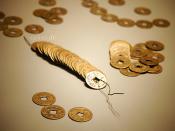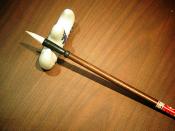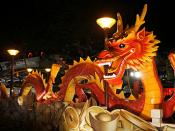Chinese immigrants first came to Victoria in large numbers during the
goldrushes of the 1850s and Melbourne's Chinatown began as a staging
post for the many thousands of Chinese passing through Melbourne on
their way to the goldfields. The overwhelming majority came from small
farming villages in the Sze-Yap (meaning Four Districts) area of
Kwangtung, China's southernmost province. Since the late eighteenth
century, young men from this region had been accustomed to migrate
temporarily to other countries. They sent back money to increase the
prestige of their clans and hoped eventually to return home themselves.
Melbourne's Chinatown is the oldest in Australia.
Lacking both capital and skills, the Chinese saw gold mining as a good
way to make a quick fortune. Why Little Bourke Street became their
Melbourne centre is not clear, although, like other Chinatowns, it had
been a low rental area on the outskirts of the city. The first residents
occupied a cluster of shops and boarding houses in Celestial Avenue and
then in Little Bourke Steet itself, between Swanston and Russell Streets,
in late 1854 or early 1855.
By the late 1850s, the zone comprised lodging
houses, provision stores, Chinese butchers, candlemakers and opium
manufacturers, all serving the needs of upcountry Chinese. Several shops
operating today in Little Bourke Street are run in a traditional manner
and stock a range of goods very similar to that of the quarter's
earliest shops. The building at 212-220 Little Bourke Street was
erected in 1883 and it has since been occupied variously by Chinese
fruit merchants, a fancy goods importer, a banana store and a Chinese
'cook shop'. Other Chinese businesses had formerly occupied the site.
This sequential Chinese occupancy of buildings is typical of Chinatown.
The Num Pon Soon building at 200-202 Little Bourke Street also dates from
this period and is one of Chinatown's oldest buildings. Built in 1862,
probably to the design of the early Melbourne architect Peter Kerr,
the building has been used as a district association meeting place and
worship hall by Sam-Yap people for over a hundred years.
(The Sam-Yap or Three District people are another Cantonese group,
in a minority among nineteenth century Chinese in Melbourne.) The Num
Pon Soon building is one of only two district association buildings
surviving in Chinatown today. The other, the Sze-Yap building at 124-136
Little Bourke Street, was built in 1911 but its facade was thoroughly
re-modelled in the early 1960s. Many such district associations were
formed in Western countries by Chinese sojourning abroad, to provide
social amenities and for mutual protection, and in the past they occupied
a central position in the lives of most Chinatown residents. Two car
parks in Little Bourke Street, at numbers 242-244 and 208-210, are the
sites of former district association clubhouses.
In 1859, the resident population in Chinatown of perhaps 50 people
comprised only a tiny fraction of the colony's population of more than
40,000. But as the more easily won alluvial gold was worked out and
restrictive legislation stemmed the flow of new immigrants, the remaining
Chinese turned to the towns and Melbourne's Chinatown grew larger.
Lodging houses and provision stores made way for businesses serving the
wider non-Chinese community.
Through a network of international trading links, Chinese merchants came
to control the wholesaling of bananas, tomatoes and some other tropical
fruits and vegetables in Melbourne, and their premises stretched out along
Little Bourke Street from Swanston to Exhibition Streets. Buildings
extanct today which were Chinese merchants' establishments include those
at 112-114 Little Bourke Street (erected for Lowe Kong Meng, Melbourne's
best known nineteenth century Chinese citizen) and the Geraldton
Trading Company building at 185-197 Russell Street.
The Chinese also entered the cabinet-making trade during this period and
flourished to such an extent that European competitors fomented a storm
of anti-Chinese feeling. By 1907, Chinatown had extended northwards to
Little Lonsdale Street and its adjoining lanes (where the cabinet-makers
were concentrated) and east as far as Spring Street. The Commonwealth
Government offices development has made a great impact in this northern
sector, demolishing dozens of buildings and eliminating many former lanes.
Very little evidence remains of the scores of Chinese cabinet-making
establishments once located there.
The internal community organisation of Chinatown also become more complex
in this period, with regional loyalties giving way to political loyalties
as China became de-stabilised in the first decades of this century.
The Chinese Nationalist Party building, at 107-109 Little Bourke Street,
is representative of this phase of Chinatown's history.
In 1904, during the Boxer Rebellion, rival groups of the Yee-Hing secret
society and the Bo Leong, an organ of the Sze-Yap Society, engaged in
street fighting outside the building. The Melbourne branch of the Chinese
Nationalist Party, or Kuomintang, was formed in 1916 and in 1921 it
assumed ownership of the building - which had previously been occupied
by an unidentified political group - and had the facade revamped to the
design of Walter Burley Griffin. Unfortunately, this facade is now
defaced. A number of Chinese Christian churches date from this period -
the Chinese Methodist Church at 196 Little Bourke Street; the former
Presbyterian Mission Church at 108-110 Little Bourke Street, and the
Church of England Chinese Mission of the Epiphany at 119-125 Little
Bourke Street. In general, the churches provided a westernising influence
among Chinatown people, cutting across clan and regional loyalties.
Chinatowns throughout the world have seemed to outsiders to be exotic
localities, as often forming a city within a city, and with a closed and
sinister reputation. Melbourne's Chinatown has certainly had this
reputation. Most Melburnians in the late nineteenth century regarded
the Chinese as immoral, avaricious and devious and Little Bourke Street
as a sink of iniquity. Popular journalists played on fears of moral
contagion, producing lurid descriptions of the quarter's gambling halls,
opium dens and brothels. Close by was the 'Little Lon' red light district,
while at the Spring Street end of Little Bourke Street, Gordon House
was the city's main refuge for homeless and derelict men.
Popular fears of the Chinese were given legislative expression in the
labour, trade and immigration laws of the early Commonwealth period
and led directly to a decline in Melbourne's Chinese quarter. Cabinet-makers
who returned to China could not be replaced and wholesale merchants
were forced out of business by legislation, such as Queensland's
euphemistically titled Banana Industry Protection Act. By the 1930s,
Chinatown had shrunk to a handful of shops and the quarter seemed doomed
to extinction. However, since the second world war it has expanded and
revived. Chinatown's cafes and shops are now very popular and are
patronised by all Melburnians, not only Chinese. Thus, although the
quarter is now much smaller than it was in the first decade of the
century, it is by no means a relic feature; its business establishments
are viable, even booming, and Chinatown has merely entered another
phase of its development. At the same time, old established social
institutions (churches, district associations, political organisations)
provide a continuity with the pre-war period and offer undeniable visual
evidence of a unique and little known aspect of the city's history.
Character and Significance
The significance of Chinatown is embodied in its distinctive townscape
and in its unique history. The distinctive townscape of the area
derives from the preponderance of nineteenth century low-rise buildings,
combined with a present day concentration of Chinese businesses and other
concerns. In Little Bourke Street, in Celestial Avenue and, to a lesser
extent, in the other lanes of the Conservation Area, the buildings form
strips of nineteenth century commercial streetscape which were once common
in many of the 'little' streets and lanes of Melbourne's Central Activities
District, but which have now almost completely disappeared; replaced by
post-war high-rise development.
The contributory buildings are nearly all constructed of brick, are of one,
two or three storeys, modestly conceived and erected on narrow allotments.
Few of the buildings were architect designed, but together they display
a variety of nineteenth century architectural styles - classical, gothic,
mannerist and other - which contribute to a typically Victorian eclecticism
of streetscape. Several of the buildings are of individual architectural
merit, notably the Num Pon Soon buildings, the Chinese Methodist Church,
the Sun Kum Lee building, the former Presbyterian Church, the Church of
England Chinese Mission of the Epiphany and the former Globe Hotel.
Of these, the Num Pon Soon building and the Sun Kum Lee building display
unmistakable Chinese decorative motifs. However, it is not the design of
the buildings which gives a distinctively Chinese atmosphere to the
area as much as the buildings' uses - as Chinese cafes, grocery stores,
district associations, churches - and the accompanying Chinese shop
displays, signs, advertisements and street archways. All these elements
together indicate that the quarter is prosperous, lively and economically
viable and that it is demonstrably different in character from any other
part of Melbourne.
This concentration of Chinese businesses, associations and people is
recognised by most Melburnians and allows the area legitimately to be
called a 'Chinatown'. Chinatowns are found in many western and south-east
Asian cities and there were once a number of Chinatowns in mining and
rural settlements throughout Australia, but today Melbourne's Chinatown
is one of only two that remain in this country, the other being in
Sydney.
Chinatowns are very important historically. They are a special settlement
from which has resulted from a combination of factors - that of sustained,
selective outmigration from southern China, combined with an unwillingness
of recipient countries to integrate the Chinese migrants into the
mainstream of their society. The result was ethnic enclaves, typically
located in small mining towns or on the fringes of city centres.
Here, the Chinese were able to concentrate their own social institutions
and, in some cases, develop a light industry base (cabinet-making in
Melbourne, clothing in Boston, boot and shoe manufacturing in San
Francisco). The enclaves were seen by outsiders as 'a city within a city'
with strange people, shops, dress, smells and with the reputation as
centres for sinister and illegal activities.


